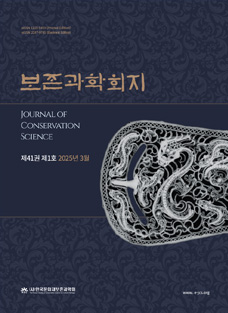Journal of Conservation Science Vol.30 No.4 pp.457-466
대가야 고아동 고분벽화 제작기술에 관한 연구
Study on the Manufacturing Technology of Mural Tomb in Goa-dong of Daegaya Period
Hwa Soo Lee,Han Hyeong Lee,Kyeong Min Lee,Kyeong Soon Han
Abstract
Rigorous analysis was performed to identify the structure and materials of the murals to study techniques used on mural tombs of ancient Daegaya era(6th century). The murals were painted by applying mortar on the walls and the ceiling after building a stone chamber and creating ground layers on mortar layers. Mud was applied on most of the mortar layers on four sides of the walls except the ceiling. Sand was not used in mortar but was made of materials with pure calcium substances. In addition, shells in irregular sizes with incomplete calcination were mixed; and the mortar's white powder was inferred as lime obtained by calcination of oyster shells. Kaolinite(Al2Si2O5(OH)4) was used in the ground layer, Cinnabar(HgS) was used for red pigment, Malachite(Cu2CO3(OH)2) for green and Lead white(PbCO3·Pb(OH)2) for white. Mud plaster was applied on the mortar and was composed thinly and densely using clayey of particle size smaller than that of medium sand. It was assumed that the finishing was for repair after long time had passed since the mortar layer came off. Using lime made with oyster shells as mortar is unprecedented in ancient Korean mural tombs and its durability was very poor, suggesting that Gaya's mortar production technique was relatively behind compared to that of Koguryo's in the same era.

 E-Submission
E-Submission 
 E-Submission
E-Submission 
![]() Journal Search Engine
Journal Search Engine




 KSC
KSC